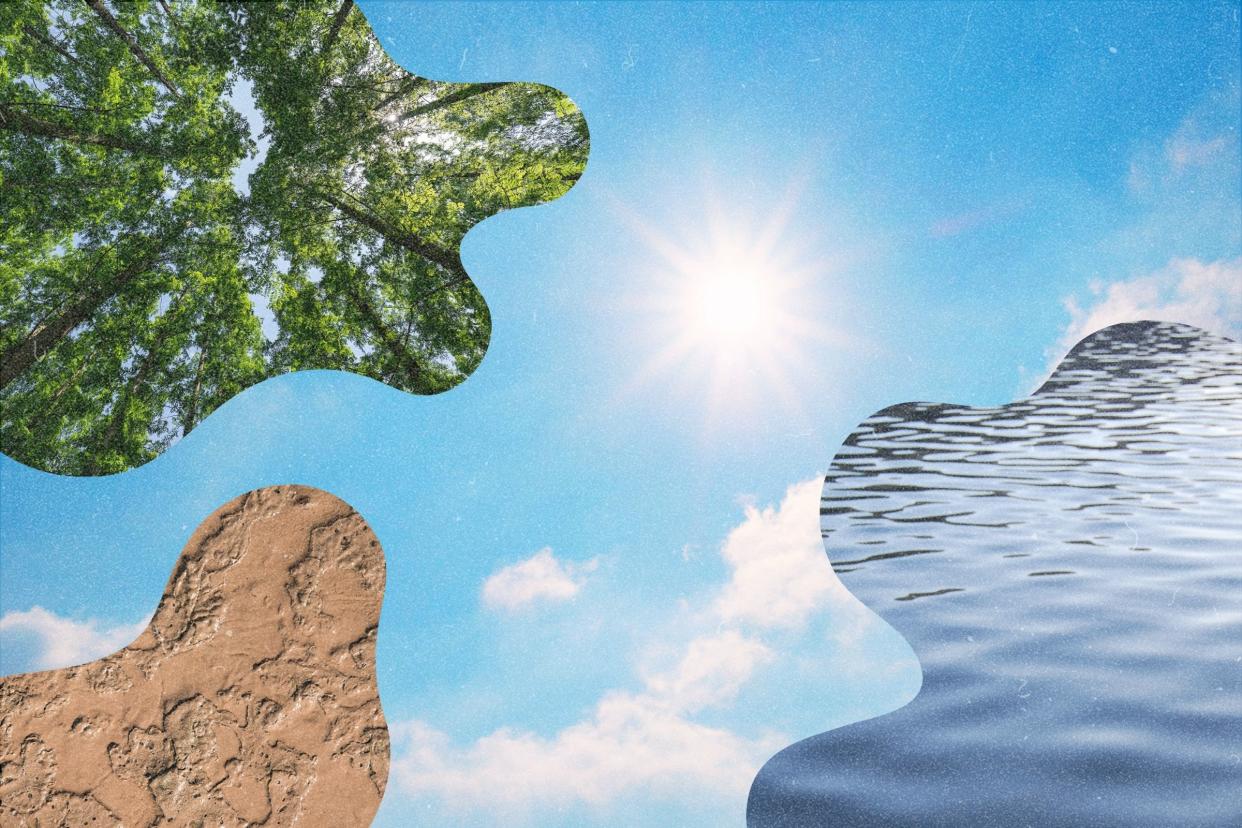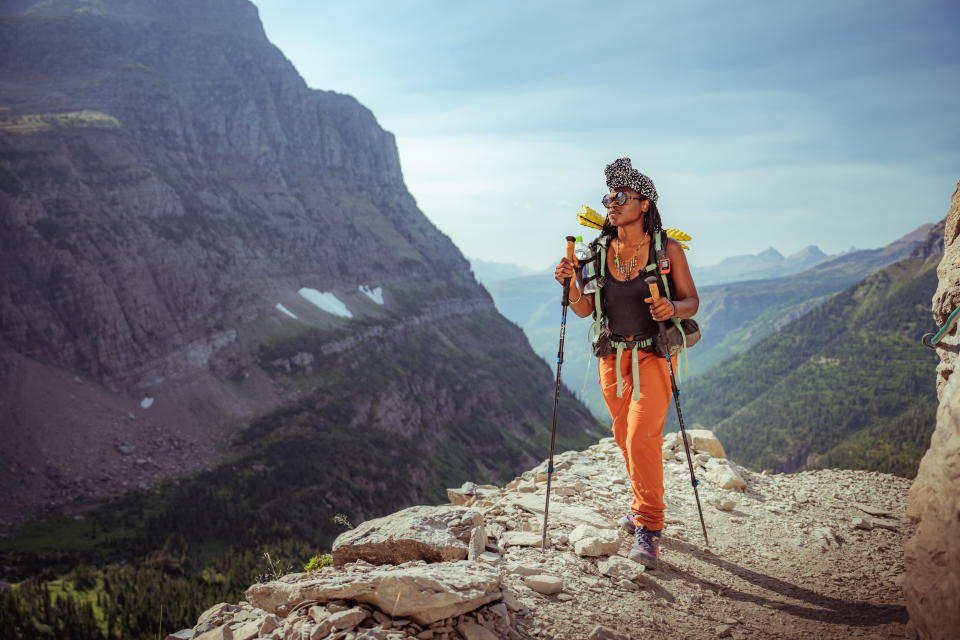How to Spend Time Outside If You Hate Getting Sweaty

Credit - Photo-Illustration by TIME; Getty Images (4)
Shilletha Curtis has logged thousands of miles hiking the world’s most challenging trails—and turning into a sweaty, sticky mess along the way. The dry heat of the Continental Divide Trail, which stretches from Mexico to Canada, is vivid in her memory. But the absolute most scorching? That would be the Appalachian Trail, a nearly 2,200-mile trek from Georgia to Maine. When she spent eight months hiking it a few years ago, “It was so hot,” she remembers. “You’re knee-deep in mud, there’s black flies biting you, and you’re just sweating.”
And sweating, and sweating. The sweat dripped; it beaded. It pooled in her shoes and saturated her clothes. It exuded from every part of her body. Yet it didn’t phase her. Instead, Curtis, who’s the author of the new book Pack Light: A Journey To Find Myself, found ways to adapt. She’s proof, she says, that it’s possible to enjoy time outside in the summer heat even if you’re bleeding sweat.
Though sweating gets a bad rap, it serves an essential function, says Dr. Casey Kelley, founder and medical director of Case Integrative Health in Chicago. “Its first function is to cool us down and prevent overheating,” she explains. “It’s a good thing when we’re hot—it’s our body’s way of trying to protect us.” Without it, we’d have a difficult time controlling body temperature. Still, that doesn’t change the fact that some people find sweat uncomfortable and stinky.
If you’re one of them—and sweat strikes you as the ultimate summer threat—consider these strategic ways to still enjoy spending time outside on hot days.
Time your activities wisely
Michael Collins designs and manages multi-day adventures for REI Co-op—which means he’s led eager travelers through national parks from Shenandoah to the Grand Canyon. “Heat is ever present,” he says. “It’s a big topic for the participants, and it goes beyond comfort all the way to safety.” Figuring out a way to keep people from dissolving into sweaty messes is essential, he says, because “at the end of the day, we’re taking people on vacation, and it’s gotta be something they look back on and love.”
That means Collins pays special attention to timing. Generally, it’s best to be active in the early mornings (before 10 a.m.) and evenings (after 4 p.m.), which are on either side of the sun’s peak hours. One of Collins’ favorite experiences to lead is a hike across the Grand Canyon, from the north rim to the south rim, with an overnight at Phantom Ranch lodge at the bottom of the canyon. On one trip, temperatures shot over 113°F. The night before, “The park rangers were like, ‘Hey, we want to prove to you all how hot it is out here.’ So they took a frying pan and put some oil in it and fried an egg out in the yard.” That was all the motivation the group needed to hit the trail at 4 a.m. and reach their destination before it got too hot, spending the rest of the day relaxing in the shade.
Dress for the heat
If you’re venturing outside in the heat, avoid dark colors and wear light, breathable fabrics, like linen or cotton. But keep in mind that your exact attire should depend on your geographical whereabouts. “If you’re hiking in the Southwest where there’s no humidity, cotton clothing is really nice,” Collins says. A plain white cotton shirt “will get wet and stay wet, and all that evaporative cooling is wonderful.” When he ventures to, say, Great Smoky Mountains National Park in the Southeast, however, where humidity is often high, he opts for quick-dry materials like polyester, nylon, and merino wool. Sometimes, when it’s especially hot, he finds he's more comfortable wearing long sleeves made from those materials than he would be if his arms were exposed to bake in the sun.
Thinking through even the smallest detail of your outfit can make a big difference, too. Richard Campbell, founder of 10Adventures, which specializes in organizing active vacations, spends lots of time traveling with his wife—who loves the outdoors but hates getting sweaty. She’s realized it makes more sense to wear a waist belt instead of a backpack, he says. That way, “she doesn’t have shoulder straps under her armpits and a pack on her back,” which allows for better ventilation and keeps her cooler.
Read More: What to Wear When It’s Really Hot Outside
Always wear a hat
Here’s a new slogan for the summer: Hat hair, don’t care. Exactly what kind you opt for will depend on personal preference. Some people love baseball hats, while others find they make them feel extra sweaty. “Look for a hat with a big bill that can protect you from the sun, and for something that's breathable,” Kelley says. Ideally, your hat will have a brim wide enough to cover your face, neck, and shoulders; it’s also important to look for one with a UPF rating of at least 50, which means it will block 98% of UV radiation.
You could also see if you like wearing a neck gaitor, which is a stretchy tube of fabric that can protect the head, neck, and face. “I love buffs—it’s just kind of the hiker style,” Curtis says. “Especially the versatility: I could put it on my head if I was sweating too much, and it would trap the sweat so it didn't get in my eyes.” Parasols prove similarly useful, she adds. She hiked the majority of the Appalachian Trail with a hands-free umbrella that attached to her backpack and helped block the sun, keeping her cool.

Take a spray bottle
The next time you head into the heat, take one of the little spray bottles you have sitting around your kitchen or bathroom. Fill it with water, and when you start to get sweaty, spritz yourself. You can even share with your friends if you’re feeling generous. “You’re the hit of the trail if you’ve got that spray bottle,” Collins says with a laugh.
Take a mud bath
So you don’t want to be covered in sweat. But what about a totally different substance? When Curtis is on a long, hot hike, she often enjoys taking a mud bath. “At the end of the day, I’m going to be dirty anyway,” she says, and mud has a cooling effect. She’ll usually pick some up from a little ways off the trail—not the heavily trafficked part—and smear it all over herself. She keeps it on until it naturally dries off. “It makes things a little more bearable,” she says. “And it’s like you’re a kid. You get to play in the mud again.”
Plan water activities
If Curtis arrives at a water hole or stream while she’s hiking, you better believe she’s jumping in. Sometimes she lays down in shallow rivers—bonus points if there’s a waterfall within sight. “It’s a really cathartic feeling,” she says. “If there are waterfalls and they’re accessible, I would go under them and just splash and get cold.” Of course, not every trail has proximity to water, so in those cases, Curtis would do the next best thing: Pour some of her water all over her head. Non-hikers can utilize water to avoid getting sweaty, too. Aim to relocate summer gatherings to local lakes or swimming pools, so you can easily cool down and wash sweat away.
Read More: How to Deal With Sweaty Feet
Find—or create—shade
Curtis sets a rule for herself while hiking: Rest wherever possible. When she was on the Continental Divide Trail, passing through places like steamy New Mexico, she took a break and sat down under every tree she saw. If you’re not sure where to find shade, ask passersby for tips.
You can also create your own shade: The first thing Campbell and his wife do when they go camping is set up a big tarp that provides rain and sun relief. “Many a day at the campsite is saved by being able to escape to the shade of our tarp,” he says. The more you’re able to hide from the sun, the less sweat you’ll feel pouring out of your body.
Invest in some portable supplies
One of the key steps to spending time outside while minimizing the sweat factor is being prepared. Kelley suggests taking deodorant wipes or travel-size deodorant you can reapply as needed, as well as facial blotting paper. “You can dot your face to help soak up some of the sweat,” she says. People often have luck with battery-operated neck fans that can be worn during all sorts of activities, she adds. There are also cooling towels that will make you feel like you’re wearing an ice pack around your neck. Plus, you could take a change of clothes and shoes in case what you’re wearing has become uncomfortably wet. With a little planning, there’s no need to break into a cold sweat over getting insufferably sweaty this summer.
Contact us at letters@time.com.

 Yahoo Lifestyle
Yahoo Lifestyle 
